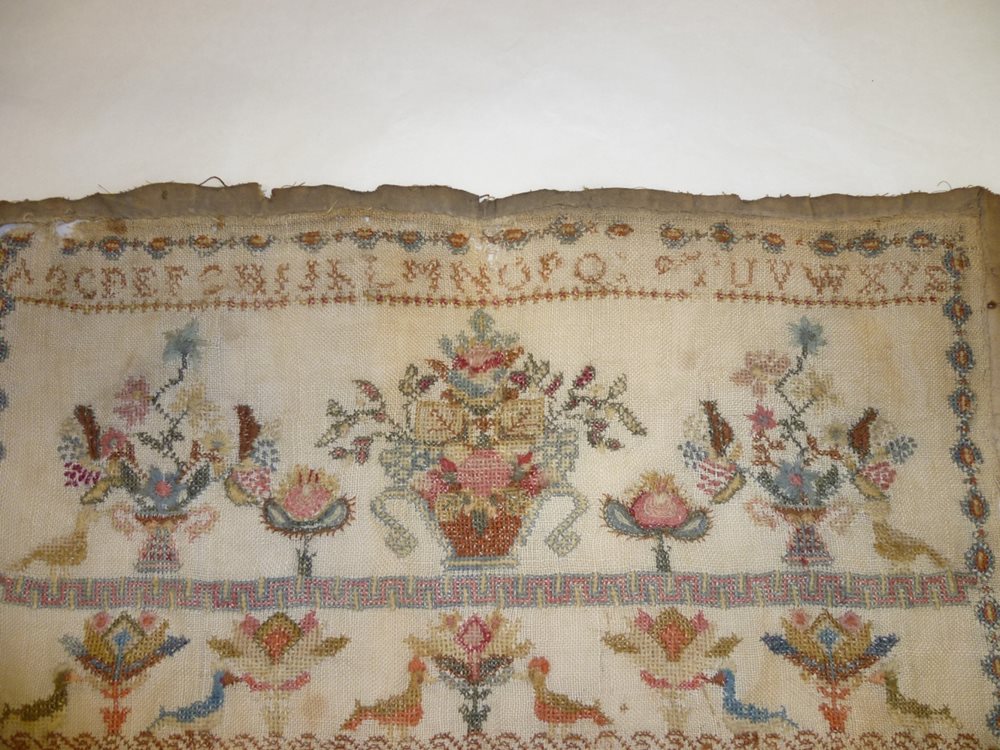1838
Nineteenth Century Sampler
A sampler made by Elenor Hickey aged 14, dating to 1838 with a macabre rhyme embroidered onto it.
By Joanne Hamilton
A square piece of white fabric measuring 43 cm by 43 cm, embroidered with different coloured threads in different stitching techniques. A band of plain fabric 2 cm in width has been stitched around the perimeter of the fabric, suggesting that the piece may have been framed at one point.
What was embroidered onto the sampler?
The sampler is embroidered primarily with a combination of letters, flowers and bird motifs. Along the top the alphabet is stitched in capital lettering and below this are three floral displays in vases reaching a height of 10 cm. Along the bottom are smaller floral displays interspersed with bird motifs in different colours.

Figure 2: Detail of embroidered fabric sampler (F:1995.323).
Half way down the fabric is the most intriguing aspect of the sampler, a personalised rhyme stitched by the maker, Elenor Hickey. It reads;
"Elenor Hickey is my name and with my needle I worked the same and by my work you may see what care my parents took of me when I am dead and in my grave and all my bones are rotton this work will tell my name when I am dead and quite forgotten. Elenor Hickey aged 14 year 1838."
Below the rhyme is a band of geometric style designs in different stitches and coloured threads. Finally, there are two more floral displays in vases with a floral motif in the centre.
What were samplers for?
The tradition of embroidering samplers was widespread across many parts of Europe, the oldest surviving examples date from the 15th and 16th centuries. The name sampler itself is derived from the old French term 'examplaire' or 'essamplaire', referring to a copy or model. Samplers were used to copy patterns and motifs that were fashionable at the time. Some of the earliest types evolved from the absence of printed needlework patterns, which encouraged designs to be reproduced onto fabric.
Needle-working was seen as an essential skill for all females at that time and the production of samplers fulfilled a number of purposes. For the wealthy classes they were made as part of a leisure activity or as show pieces. The poorer classes made them largely to practice their needlework, but also as examples of their expertise to show prospective employers.
In later times girls would have learned to stitch as part of their formal education. The repetition of patterns, numbers and letters on samplers such as this one and the neat uniform rows of the rhyme, are reminiscent of a school exercise. So too was the inclusion of the students name and age on the sampler.
Learn more...
This particular sampler is part of the reserve clothing and textiles collection at the National Museum of Ireland – Country Life.
Similar samplers can be viewed on exhibition at the National Museum of Ireland – Decorative Arts and History, Collins Barracks, Dublin 7, in the Irish Country Furniture gallery.
The Ulster American Folk Park website has an informative page about samplers.
References
King, Donald (1960). Samplers, Victoria and Albert Museum. London.
Sabba, Anne (1979). Samplers Five Centuries of a Gentle Craft. Weidenfeld and Nicolson, London.
Location:
Nineteenth Century Sampler is located at:
In Storage
Previous artefact:
Next artefact:
